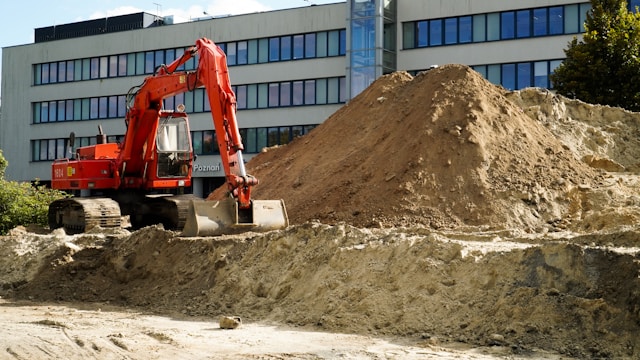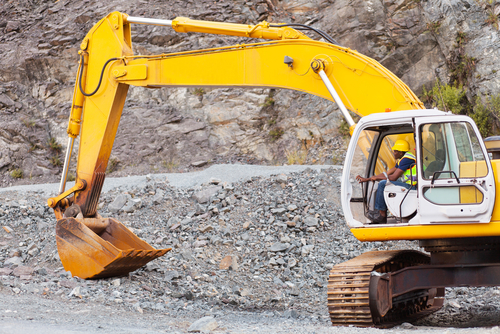What Is Earth Moving?
Earth moving is the process of removing, relocating, and shaping soil, rock, and other materials to create a level surface, prepare for construction, or modify the terrain for various purposes, such as agriculture, mining, or landscaping. This process encompasses the removal, relocation, and reshaping of soil and rock to prepare the land for a variety of applications, including laying building foundations, constructing roads, and setting up pipelines and drainage systems. By reshaping the natural terrain, earthwork specialists ensure that sites are stable, level, and primed for the subsequent phases of development.

In South Africa, earth movers and excavation specialists, commonly known as earthwork contractors, play a vital role in construction and infrastructure development. These professionals are responsible for moving large volumes of soil, rock, and other materials to shape the land for a wide range of projects. Their expertise lies in tasks such as site preparation, foundation excavation, land clearing, and terrain levelling. To carry out this work efficiently and safely, they operate heavy-duty machinery like excavators, bulldozers, and articulated dump trucks, which are used to dig, grade, cut slopes, and prepare sites for building and development. Their work forms the essential groundwork upon which all successful construction projects are built. The importance of these specialists is therefore obvious.
Examples of Large-Scale Earthworks Projects
Large-scale earthworks in South Africa include:
- Mass Excavation: Large-scale construction projects frequently require extensive excavation efforts, where significant volumes of earth are removed to establish foundations for buildings, roads, and various structures.
- Relocation and Placement: After excavation, the removed material is transported and positioned in designated areas. This process shapes the landscape by forming embankments, berms, or altering the site’s topography to align with project requirements.
- Infrastructure Development: Earthworks are crucial in the development of essential infrastructure, including roadways, railways, dams, and other pivotal projects that support community growth and connectivity.
- Mining Activities: In the mining sector, earthworks form the backbone of site preparation, the construction of tailings dams, and the relocation of extracted materials, ensuring efficient operations and resource management.
- Environmental Considerations: Large-scale earthworks can have profound environmental effects. This necessitates meticulous planning and execution to mitigate disruptions and promote sustainability throughout the project lifecycle.
- Road Construction: Major projects such as new highway constructions or the expansion of existing roads typically involve substantial earthworks to create appropriate roadbeds and embankments.
- Dam Construction: Building dams requires considerable earthmoving to create both the dam structure and its foundational base, ensuring safety and stability.
- Mining Projects: Extensive excavation and displacement of earth are critical for mining operations, including the development of open-pit mines and tailings facilities, which manage waste materials.
- Infrastructure Development: Various projects involving railways, pipelines, and other infrastructure components heavily rely on earthworks to facilitate efficient and effective construction.
Earthworks Specialists’ Responsibilities include:
- Excavation: Digging trenches, pits, and open excavations for foundations, basements, and other underground infrastructure projects.
- Grading and Shaping: Creating level surfaces, slopes, and contours for a variety of projects, including road construction and landscaping.
- Site Preparation: Clearing land, removing vegetation, and preparing sites for building, construction or other development projects.
- Material Handling: Moving substantial quantities of soil, rock, and other materials, often utilizing articulated dumpers and other heavy machinery.
- Mining Activities: Excavating and transporting raw materials or coal as part of mining operations.
- Pipeline Installation: Assisting with the underground installation of pipelines for various utilities.
- Road Construction: Clearing sites for building roads and other essential infrastructure to accelerate transportation.
- Drainage: Establishing terraced drainage systems and digging ditches to manage water flow.
- Demolition: Carefully and safely removing structures and debris using specialised earth-moving equipment.
Essential Equipment Used in Earth Moving and Excavation
Earth-moving and excavation specialists rely on a wide range of heavy-duty machinery, each designed for specific tasks to ensure efficiency, precision, and safety on-site.
Below are some of the most commonly used types of equipment:
- Excavators
Highly versatile machines used for digging trenches, pits, and foundations. Equipped with a boom, stick, and bucket, excavators are ideal for excavation, lifting, demolition, and material handling. - Bulldozers
Powerful and efficient, bulldozers are used to push large quantities of earth, clear debris, and shape terrain. Their wide, heavy blades make them essential for grading and levelling work. - Backhoes
Combining the features of an excavator and a loader, backhoes are compact and manoeuvrable, therefore ideal for digging, lifting, and transporting materials, especially in confined spaces. - Articulated Dump Trucks (ADTs)
These rugged vehicles are designed to transport large volumes of material across rough terrain. Their articulated design offers better manoeuvrability, making them vital for moving earth on larger construction sites. - Loaders
Loaders are used to scoop, lift, and move materials such as soil, gravel, or sand. They are essential for quickly relocating materials within a site or loading them into trucks for removal. - Graders
Graders are used to fine-tune and smooth surfaces, ensuring precise grading for roads, foundations, and other infrastructure. They are essential in achieving the correct slope and level. - Scrapers
These machines cut into the soil, load the material, and transport it in one motion. Scrapers are highly efficient for large-scale earth-moving operations over wide areas. - Trenchers
Designed specifically for digging narrow, deep trenches, trenchers are commonly used for installing underground utilities such as pipes, cables, and drainage systems. - Vacuum Excavators
Vacuum excavators are non-destructive excavation tools that utilise high-powered suction to safely remove soil. They are particularly beneficial when working near sensitive underground infrastructure, such as fibre-optic cables or gas lines, as they minimise the risk of damage to these vulnerable systems.
Defining Excavation
Excavation is broadly defined as the process of digging or removing earth, rock, or other materials from the ground. It is a crucial element of construction and various earthmoving projects. There are several types of excavation, defined primarily by the material being removed, the depth of the excavation, or the intended use of the excavated area.
Excavation work can be classified into several types based on its purpose, depth, and the techniques involved. Each type serves a specific function in construction, infrastructure, or environmental management.
Common types of excavation include:
By Material:
- Topsoil Excavation. This involves removing the top layer of soil, which typically contains organic matter and vegetation, to expose a more stable subsoil that is suitable for construction.
- Earth Excavation. This type involves removing soil beneath the topsoil layer, usually in preparation for foundations, roads, or other structures.
- Rock Excavation. This process entails removing rock, which may require specialised equipment such as pneumatic hammers, drilling tools, or blasting techniques.
- Muck Excavation. This involves removing a mixture of water and soil, commonly found in wetlands or areas with poor drainage.
- Stripping (Cut and Fill). This refers to the removal of layers of soil or rock across a large area to prepare a site for construction.
By Purpose/Method
- Site Excavation. This is one of the most common forms of excavation, undertaken to prepare a site for construction. It typically involves the removal of topsoil, rocks, vegetation, and debris to create a clean, level base for building foundations or infrastructure.
- Trench Excavation. This consists of digging narrow, deep trenches, primarily for the placement of underground utilities such as water pipes, cables, electrical conduits, gas or sewer lines.
- Deep Excavation. This type of excavation is necessary for structures that extend beyond ground level, such as basements, underground parking garages, or high-rise foundations. Deep excavation demands specialised techniques and equipment to stabilise the excavation walls and manage ground pressure, especially in urban or densely built-up areas.
- Bulk Excavation. This focuses on the removal of large volumes of earth, often to re-contour a landscape or create a flat platform for major construction. It is commonly used in large-scale projects like roadworks, airports, and commercial developments, and typically involves the use of powerful machinery like bulldozers and excavators.
- Basement Excavation. This involves creating space for a basement or other underground structure.
- Footing Excavation. This entails digging trenches or pits for footings, which serve as foundations.
- Open Excavations. This includes digging large areas for foundations, basements, or landscaping purposes.
- Dredging. This form of underwater excavation is used to remove sediment, debris, or pollutants from the bottom of rivers, lakes, harbours, and other water bodies. It is essential for maintaining navigable waterways, improving water flow, preventing flooding, and preparing marine sites for construction like docks or bridges.
- Borrow Excavation. Borrow excavation, often referred to as borrow pits, involves extracting soil, sand, gravel, or other materials from one site to be used as fill or construction material at another location. This practice is particularly common in large-scale projects such as road construction, where significant volumes of material are needed. In South Africa, borrow excavations are still in use but are increasingly subject to scrutiny and regulation due to their environmental impact. While borrow pits offer a convenient and often cost-effective source of construction material, they can lead to land degradation, visual scarring of the landscape, and even contamination of nearby water sources if not managed properly. To mitigate these negative effects, rehabilitation plans are mandatory and must be implemented once the excavation is complete. These plans typically involve reshaping the land, restoring vegetation, and ensuring that the site is stable and environmentally safe. .
- Drainage Excavation. This involves digging to expose or repair drainage systems or utilities.
Each type of excavation plays a vital role in the successful execution of construction and earthmoving projects.
Excavation: Digging Deeper
Excavation is a specific form of earth moving that involves the removal of soil or rock to form holes, trenches, foundations, or basements. It’s a vital step in almost every construction project and requires meticulous planning and execution.
Excavation tasks may include:
- Digging foundations for buildings
- Trenching for utility lines
- Creating space for underground tanks, swimming pools or dams
- Removing unsuitable or unwanted soil or debris
Final Thoughts
Earth moving and excavation are foundational to virtually every construction and infrastructure project.
Though often overlooked in favour of more visible aspects of construction, these processes play a vital role in shaping the success and longevity of any project. They quite literally prepare the groundwork, ensuring the land is properly prepared to support the structures, systems, and communities that will be built upon it. Nonetheless, it is important to recognize that earthworks carry inherent risks, including cave-ins, ground instability, and equipment-related accidents, calling for best practices, prioritising safety protocols, and embracing sustainable methods, as with all building/structural work.
